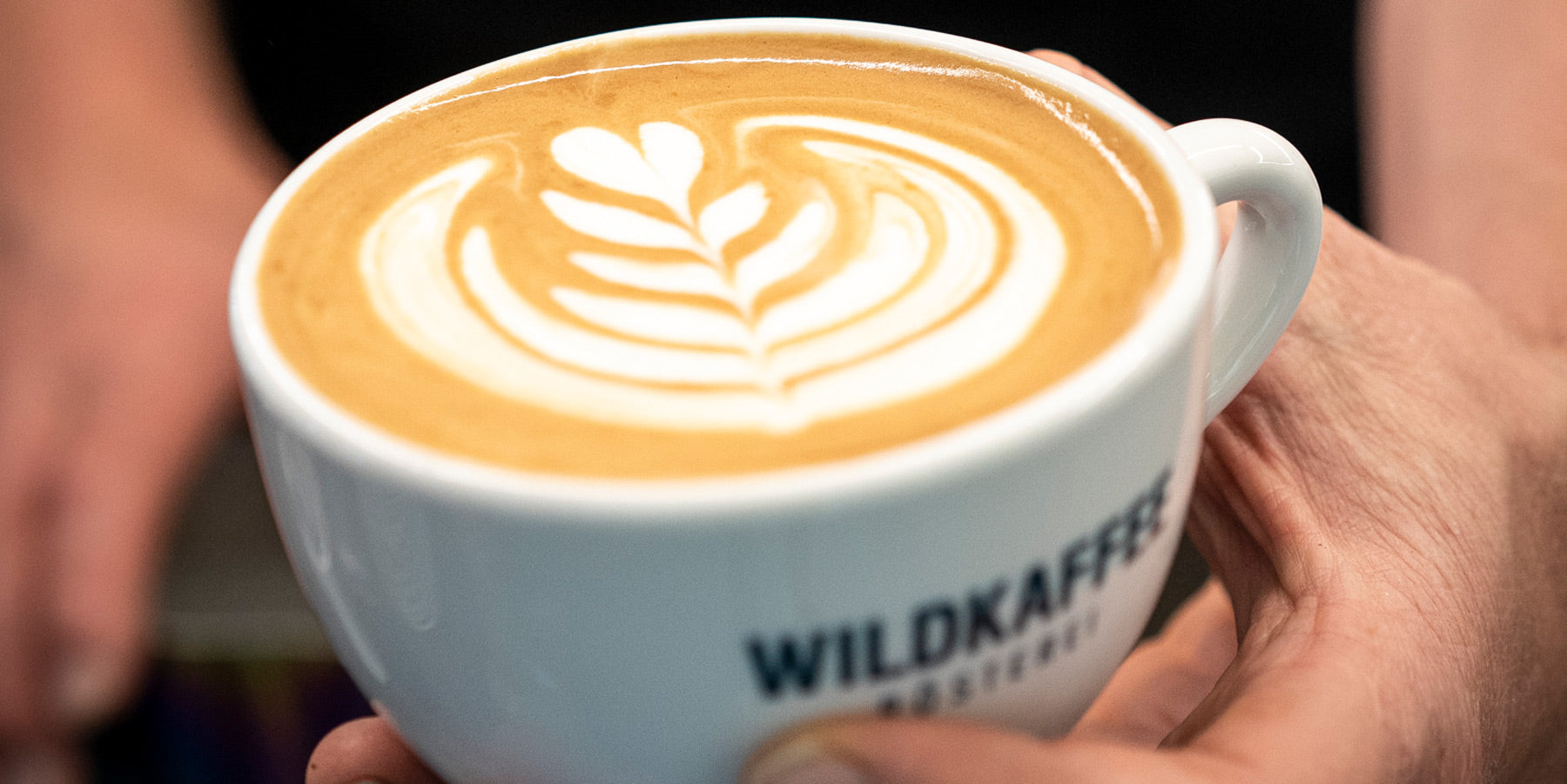We're halfway there. You can now call yourself half a barista. In the first half we clarified numerous theoretical questions. Slowly but surely we should get to the implementation, i.e. the practical part.
Now that we know how to prepare our barista workstation , what tasks we have as a barista, what accessories we need, how to choose the right coffee beans for our preparation method and which milk we should use for our cappuccino , we're going to go a step further. It's all about milk again, but today we want to show you how to properly froth the milk for your cappuccino. There are many variations and possibilities, but also things that can go wrong. Especially when it comes to the consistency of the cappuccino . But don't worry, we at the Wildkaffee Rösterei will show you how it's guaranteed to work! Elias Fischbacher from the Wildkaffee Rösterei wishes you lots of fun discovering!
Frothing milk - How and why is milk foam created?
Today we're going to look at milk in a slightly different way. Milk is a mixture that we call an emulsion . To be more precise, it is a combination of water and fats. Normally, fat and water don't go particularly well together. You might know this from trying to pour some oil into water. The film of fat settles on top because oil is lighter than water. How can fat and water combine in milk? Very simple - with emulsifiers - so-called lecithins.
And it is precisely these emulsifiers that help the milk to form foam . First of all, the surface tension of the milk must always be reduced. This is done by heating it. In this way, more emulsifiers are made available to each fat particle. The proteins and fats contained in the milk form structures that enclose the small air bubbles that are artificially added when the milk is frothed. All in all, this is how milk foam is created.

Frothing milk - what options are there?
Now that you know exactly how milk foam is created, you'll probably want to know how to froth milk perfectly. Frothing milk is an essential part of barista knowledge and should definitely not be neglected! There are a variety of ways to do it. Since we're taking an online barista course here, we'll obviously recommend the most professional method - the steam nozzle , also known as the steam wand. This milk frother is actually built into every high-quality portafilter machine and should be standard, especially in the catering industry.
You can also find a steam wand in high-quality fully automatic machines. There are also small stick milk frothers that stir up the milk with a small whisk and create the foam. There are also manual and electric milk frothers, both of which work with a small sieve that moves up and down quickly. In summary, you can say that all variants work. The most sensitive milk frother is definitely the steam wand on the portafilter machine. With this method and the right technique, you can create your own perfect milk foam! You will now find out how we want to achieve the perfect foam.

Froth milk - the perfect milk foam!
Let's get to the perfect milk foam! Especially in the beginning, most aspiring baristas tend to froth the milk far too thickly. It may not look so bad at first, but in practice, i.e. in the cup, it quickly becomes clear that there is still room for improvement! Milk foam that is too thick prevents the ideal mixture of espresso and milk.
But what are the characteristics of the perfect milk foam? We generally describe the perfect milk foam as creamy. This creaminess is achieved through a combination of the characteristics "firm", "fine-pored" and "loose" . This means that it combines perfectly with the flavorful espresso and also makes pouring an artistic latte art much easier.

Which milk is perfect for frothing?
In the last article, we devoted ourselves entirely to the perfect milk for your cappuccino. In this section, however, we would like to briefly explain to you which milk we prefer to use for our cappuccino. We differentiate between plant-based milk and conventional cow's milk . As a plant-based alternative, we recommend the Oatly Barista Edition. The delicious oat milk can be foamed perfectly! Pouring latte art is also no problem.
When it comes to cow's milk, we recommend the high-fat versions with between 3.5 and 3.8% ! We also prefer fresh milk to long-life whole milk. Long-life milk usually has a slightly bitter aftertaste. It's best to get your milk from a local farmer or a local dairy. This way, you promote the local economy and support local agriculture. Knowing where it comes from is the magic word. This applies not only to our coffee, but also to the milk.
Frothing milk - How it works!
In our YouTube video we show you step by step how to froth your milk perfectly! Of course we will also show you here how to make the perfect milk foam in 7 steps. Since we are in the online barista course, we will show you how to froth milk using the steam wand of the portafilter machine. Have fun trying it out!
1. Preparation
Fill your milk jug with about 200ml. You can use the small notch towards the spout of the jug as a guide. Also have a second jug and a thermometer ready if necessary.
2. Let off some steam!
When your portafilter machine heats up, condensation forms in the machine's pipes. So briefly lower the lever and let the steam and the condensation out of the pipes. If you have a thermometer, you can now put it in your milk jug.
3. Froth the milk!
Hold your jug with your left hand on the handle and with your right hand on the outside towards the bottom of the jug. Position the steam wand more to the side and around 2cm above the bottom of the jug. Now let steam flow into the milk and gradually pull the jug downwards. The steam wand should now be just below the surface of the milk. You can tell by the rotation of the milk. You will also hear a hissing sound! Once you have achieved the desired amount of milk foam and consistency, move the lance back towards the bottom of the jug. The milk should be heated to around 60 degrees. If you don't have a thermometer, you can easily tell the temperature like this: if the jug is too hot for your hand, then you have reached the right temperature.
4. Knock
You will now definitely see some large or small bubbles on the surface. But we don't want these in our milk foam. So tap the jug a few times so that the air bubbles are distributed and the annoying bubbles burst. This will give the milk foam its even creaminess.
5. Pouring
Now pour the milk into the second jug that we provided at the beginning of the milk frothing process. By pouring the milk foam into the jug, it will have the optimal consistency for your coffee milk foam.
6. Preparation
The frothed milk should be used immediately after preparation. If it is left standing for too long, it will lose temperature and collapse. You will definitely not be able to use it anymore.
7. Very important! – Cleaning
You should clean the steam wand and your milk jug immediately after use. If the milk foam dries, cleaning is difficult and not particularly convenient. Regular hygiene is also part of being a barista!
Conclusion
We prefer to describe the perfect milk foam as creamy. This creaminess is made up of the components "solid", "fine-pored" and "loose". If these three factors are perfectly coordinated, the result is a perfectly creamy milk foam that is also perfect for pouring a latte art . You can achieve the perfect milk foam with either oat milk or high-fat cow's milk , preferably fresh milk and from regional producers. Milk frothing works best with the steam wand of a portafilter machine. But manual, electronic or stick milk frothers can also be used. #staywild


